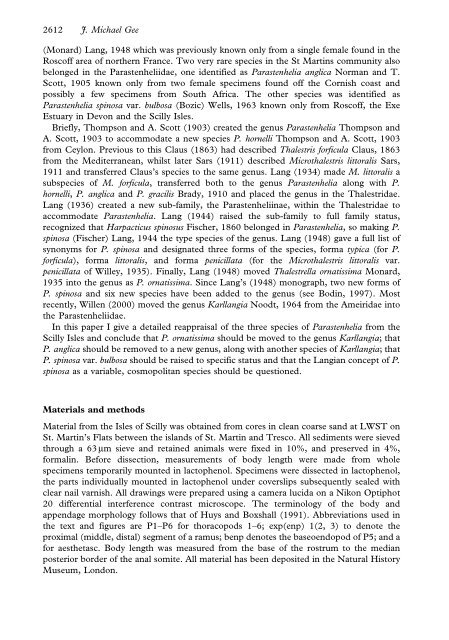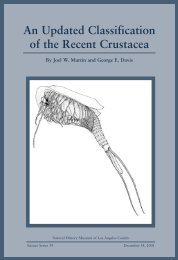Parastenheliidae (Copepoda: Harpacticoida) from ... - Luciopesce.net
Parastenheliidae (Copepoda: Harpacticoida) from ... - Luciopesce.net
Parastenheliidae (Copepoda: Harpacticoida) from ... - Luciopesce.net
Create successful ePaper yourself
Turn your PDF publications into a flip-book with our unique Google optimized e-Paper software.
2612 J. Michael Gee<br />
(Monard) Lang, 1948 which was previously known only <strong>from</strong> a single female found in the<br />
Roscoff area of northern France. Two very rare species in the St Martins community also<br />
belonged in the <strong>Parastenheliidae</strong>, one identified as Parastenhelia anglica Norman and T.<br />
Scott, 1905 known only <strong>from</strong> two female specimens found off the Cornish coast and<br />
possibly a few specimens <strong>from</strong> South Africa. The other species was identified as<br />
Parastenhelia spinosa var. bulbosa (Bozic) Wells, 1963 known only <strong>from</strong> Roscoff, the Exe<br />
Estuary in Devon and the Scilly Isles.<br />
Briefly, Thompson and A. Scott (1903) created the genus Parastenhelia Thompson and<br />
A. Scott, 1903 to accommodate a new species P. hornelli Thompson and A. Scott, 1903<br />
<strong>from</strong> Ceylon. Previous to this Claus (1863) had described Thalestris forficula Claus, 1863<br />
<strong>from</strong> the Mediterranean, whilst later Sars (1911) described Microthalestris littoralis Sars,<br />
1911 and transferred Claus’s species to the same genus. Lang (1934) made M. littoralis a<br />
subspecies of M. forficula, transferred both to the genus Parastenhelia along with P.<br />
hornelli, P. anglica and P. gracilis Brady, 1910 and placed the genus in the Thalestridae.<br />
Lang (1936) created a new sub-family, the Parastenheliinae, within the Thalestridae to<br />
accommodate Parastenhelia. Lang (1944) raised the sub-family to full family status,<br />
recognized that Harpacticus spinosus Fischer, 1860 belonged in Parastenhelia, so making P.<br />
spinosa (Fischer) Lang, 1944 the type species of the genus. Lang (1948) gave a full list of<br />
synonyms for P. spinosa and designated three forms of the species, forma typica (for P.<br />
forficula), forma littoralis, and forma penicillata (for the Microthalestris littoralis var.<br />
penicillata of Willey, 1935). Finally, Lang (1948) moved Thalestrella ornatissima Monard,<br />
1935 into the genus as P. ornatissima. Since Lang’s (1948) monograph, two new forms of<br />
P. spinosa and six new species have been added to the genus (see Bodin, 1997). Most<br />
recently, Willen (2000) moved the genus Karllangia Noodt, 1964 <strong>from</strong> the Ameiridae into<br />
the <strong>Parastenheliidae</strong>.<br />
In this paper I give a detailed reappraisal of the three species of Parastenhelia <strong>from</strong> the<br />
Scilly Isles and conclude that P. ornatissima should be moved to the genus Karllangia; that<br />
P. anglica should be removed to a new genus, along with another species of Karllangia; that<br />
P. spinosa var. bulbosa should be raised to specific status and that the Langian concept of P.<br />
spinosa as a variable, cosmopolitan species should be questioned.<br />
Materials and methods<br />
Material <strong>from</strong> the Isles of Scilly was obtained <strong>from</strong> cores in clean coarse sand at LWST on<br />
St. Martin’s Flats between the islands of St. Martin and Tresco. All sediments were sieved<br />
through a 63 mm sieve and retained animals were fixed in 10%, and preserved in 4%,<br />
formalin. Before dissection, measurements of body length were made <strong>from</strong> whole<br />
specimens temporarily mounted in lactophenol. Specimens were dissected in lactophenol,<br />
the parts individually mounted in lactophenol under coverslips subsequently sealed with<br />
clear nail varnish. All drawings were prepared using a camera lucida on a Nikon Optiphot<br />
20 differential interference contrast microscope. The terminology of the body and<br />
appendage morphology follows that of Huys and Boxshall (1991). Abbreviations used in<br />
the text and figures are P1–P6 for thoracopods 1–6; exp(enp) 1(2, 3) to denote the<br />
proximal (middle, distal) segment of a ramus; benp denotes the baseoendopod of P5; and a<br />
for aesthetasc. Body length was measured <strong>from</strong> the base of the rostrum to the median<br />
posterior border of the anal somite. All material has been deposited in the Natural History<br />
Museum, London.











